ACURA NSX 1997 Service Repair Manual
Manufacturer: ACURA, Model Year: 1997, Model line: NSX, Model: ACURA NSX 1997Pages: 1503, PDF Size: 57.08 MB
Page 1011 of 1503
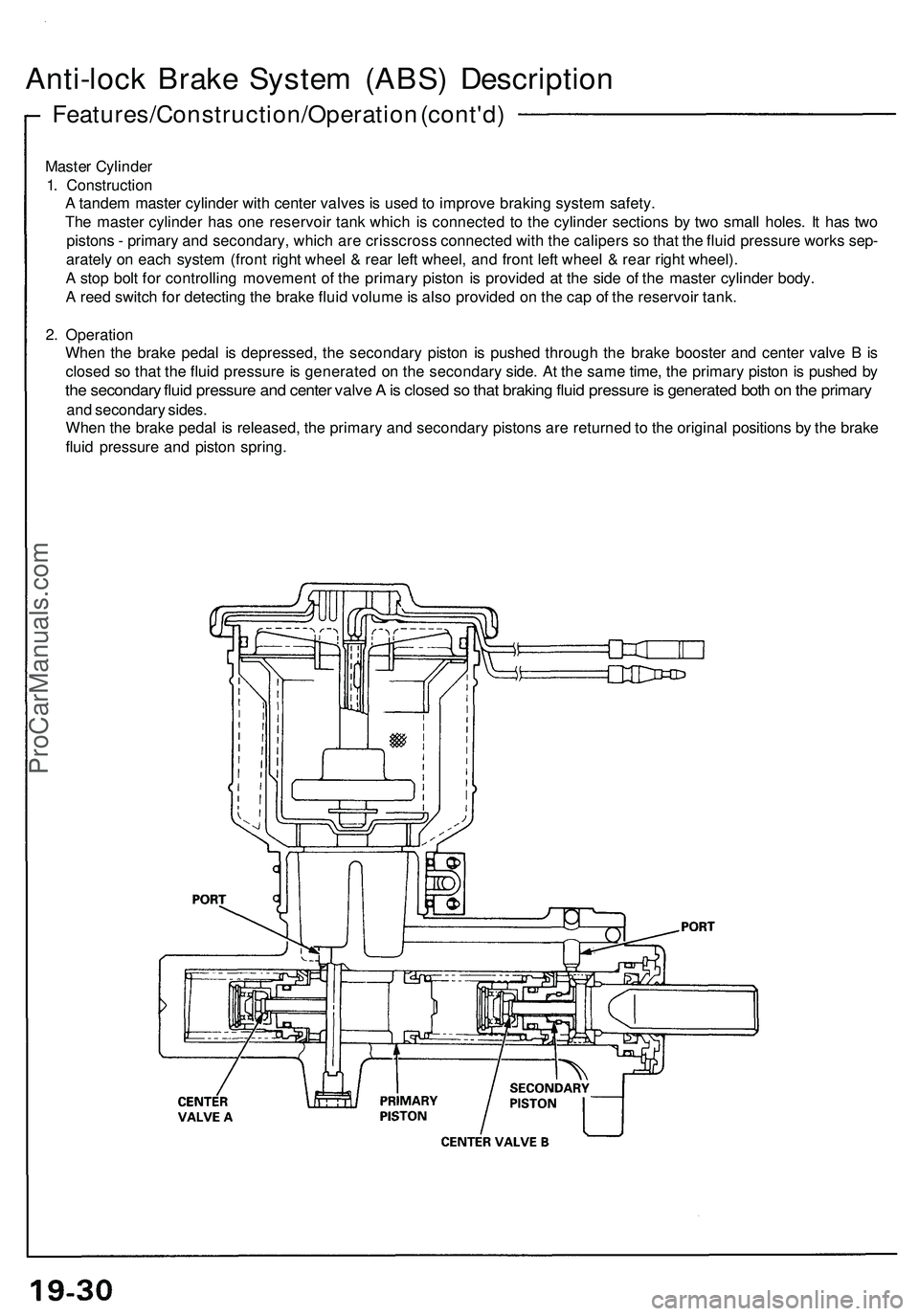
Features/Construction/Operation (cont'd)
Anti-lock Brake System (ABS) Description
Master Cylinder
1. Construction
A tandem master cylinder with center valves is used to improve braking system safety.
The master cylinder has one reservoir tank which is connected to the cylinder sections by two small holes. It has two
pistons - primary and secondary, which are crisscross connected with the calipers so that the fluid pressure works sep-
arately on each system (front right wheel & rear left wheel, and front left wheel & rear right wheel).
A stop bolt for controlling movement of the primary piston is provided at the side of the master cylinder body.
A reed switch for detecting the brake fluid volume is also provided on the cap of the reservoir tank.
2. Operation
When the brake pedal is depressed, the secondary piston is pushed through the brake booster and center valve B is
closed so that the fluid pressure is generated on the secondary side. At the same time, the primary piston is pushed by
the secondary fluid pressure and center valve A is closed so that braking fluid pressure is generated both on the primary
and secondary sides.
When the brake pedal is released, the primary and secondary pistons are returned to the original positions by the brake
fluid pressure and piston spring.ProCarManuals.com
Page 1012 of 1503
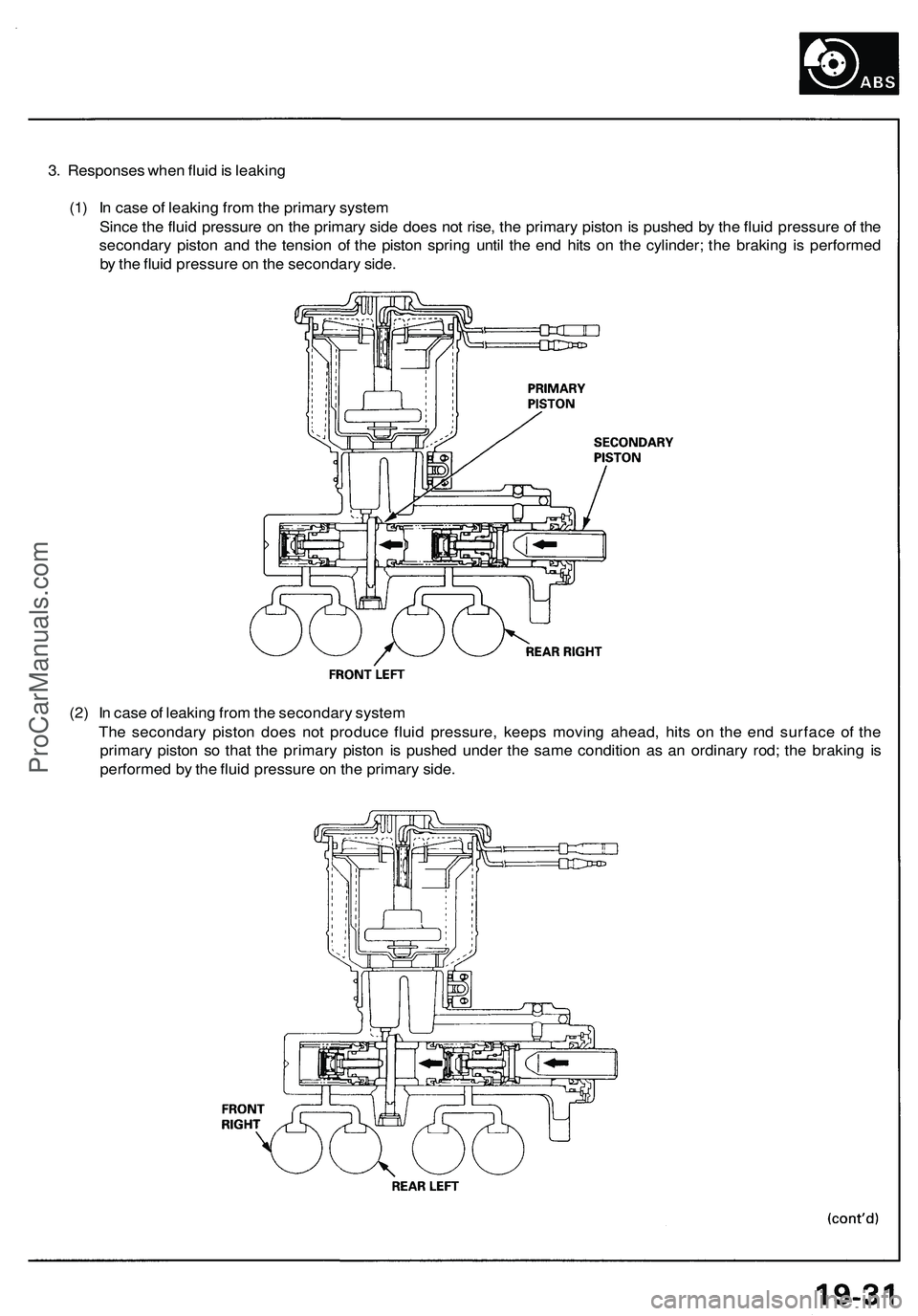
3. Responses when fluid is leaking
(1) In case of leaking from the primary system
Since the fluid pressure on the primary side does not rise, the primary piston is pushed by the fluid pressure of the
secondary piston and the tension of the piston spring until the end hits on the cylinder; the braking is performed
by the fluid pressure on the secondary side.
(2) In case of leaking from the secondary system
The secondary piston does not produce fluid pressure, keeps moving ahead, hits on the end surface of the
primary piston so that the primary piston is pushed under the same condition as an ordinary rod; the braking is
performed by the fluid pressure on the primary side.ProCarManuals.com
Page 1013 of 1503
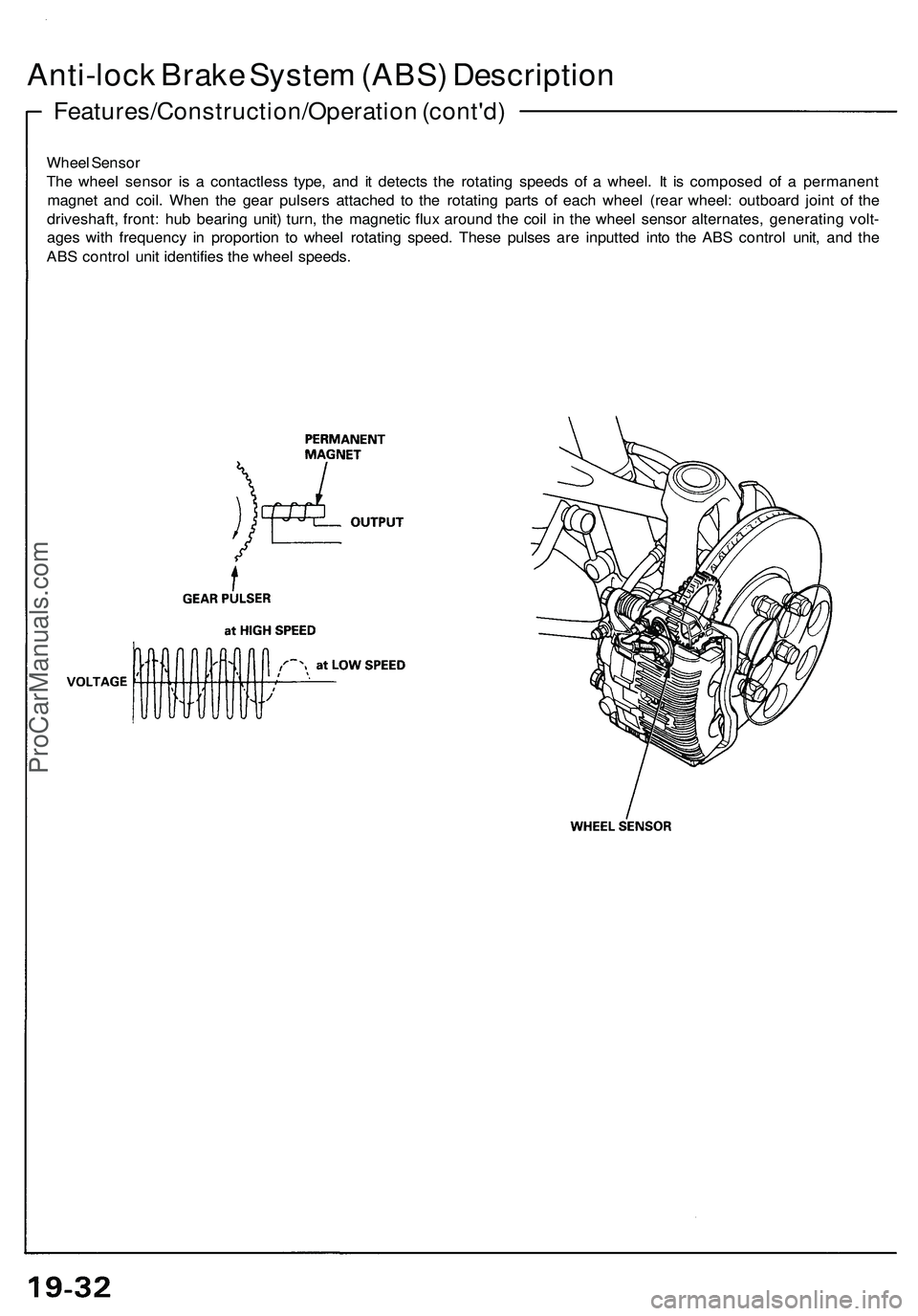
Wheel Sensor
The wheel sensor is a contactless type, and it detects the rotating speeds of a wheel. It is composed of a permanent
magnet and coil. When the gear pulsers attached to the rotating parts of each wheel (rear wheel: outboard joint of the
driveshaft, front: hub bearing unit) turn, the magnetic flux around the coil in the wheel sensor alternates, generating volt-
ages with frequency in proportion to wheel rotating speed. These pulses are inputted into the ABS control unit, and the
ABS control unit identifies the wheel speeds.
Features/Construction/Operation (cont'd)
Anti-lock Brake System (ABS) DescriptionProCarManuals.com
Page 1014 of 1503
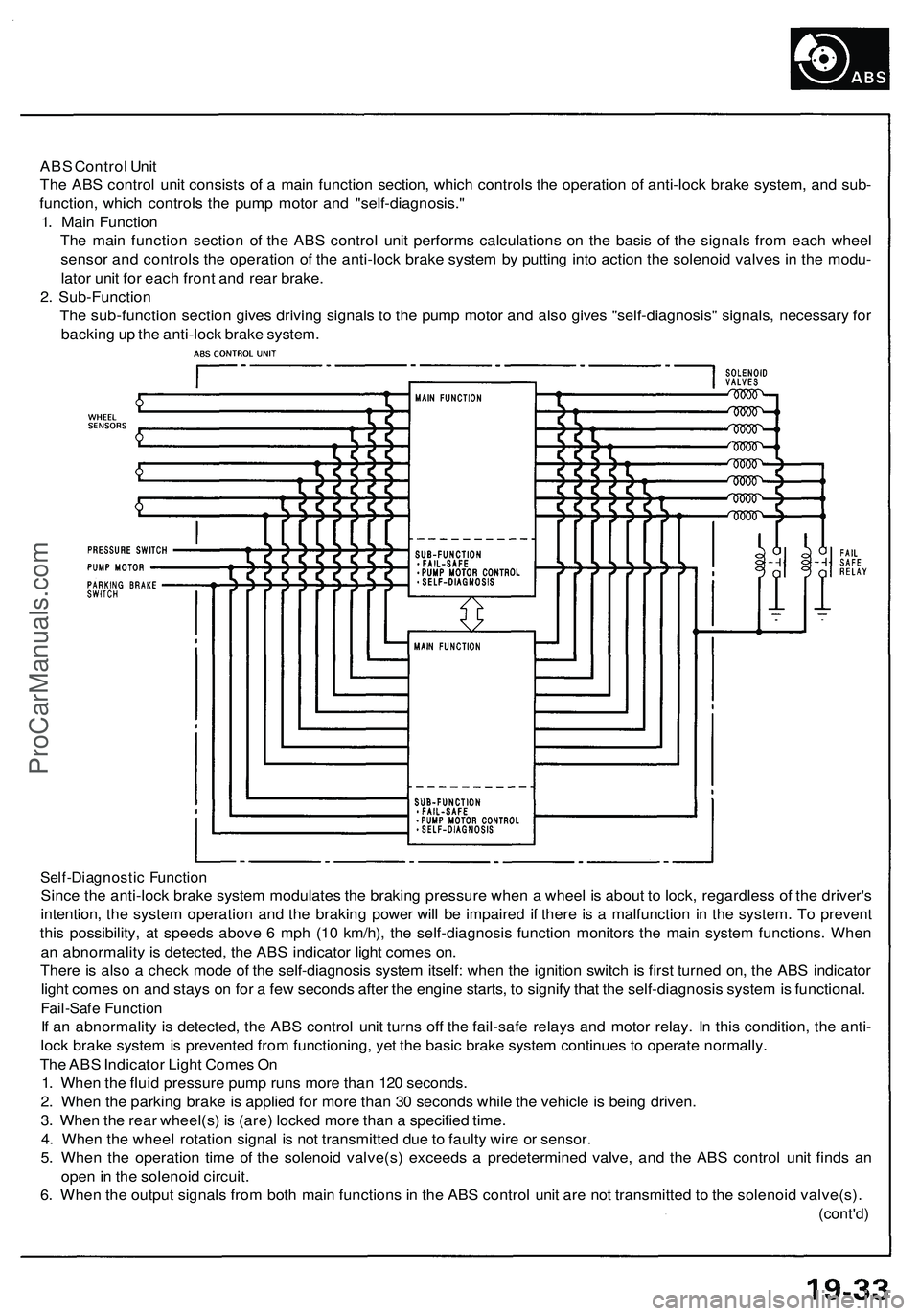
ABS Control Unit
The ABS control unit consists of a main function section, which controls the operation of anti-lock brake system, and sub-
function, which controls the pump motor and "self-diagnosis."
1. Main Function
The main function section of the ABS control unit performs calculations on the basis of the signals from each wheel
sensor and controls the operation of the anti-lock brake system by putting into action the solenoid valves in the modu-
lator unit for each front and rear brake.
2. Sub-Function
The sub-function section gives driving signals to the pump motor and also gives "self-diagnosis" signals, necessary for
backing up the anti-lock brake system.
Self-Diagnostic Function
Since the anti-lock brake system modulates the braking pressure when a wheel is about to lock, regardless of the driver's
intention, the system operation and the braking power will be impaired if there is a malfunction in the system. To prevent
this possibility, at speeds above 6 mph (10 km/h), the self-diagnosis function monitors the main system functions. When
an abnormality is detected, the ABS indicator light comes on.
There is also a check mode of the self-diagnosis system itself: when the ignition switch is first turned on, the ABS indicator
light comes on and stays on for a few seconds after the engine starts, to signify that the self-diagnosis system is functional.
Fail-Safe Function
If an abnormality is detected, the ABS control unit turns off the fail-safe relays and motor relay. In this condition, the anti-
lock brake system is prevented from functioning, yet the basic brake system continues to operate normally.
The ABS Indicator Light Comes On
1. When the fluid pressure pump runs more than 120 seconds.
2. When the parking brake is applied for more than 30 seconds while the vehicle is being driven.
3. When the rear wheel(s) is (are) locked more than a specified time.
4. When the wheel rotation signal is not transmitted due to faulty wire or sensor.
5. When the operation time of the solenoid valve(s) exceeds a predetermined valve, and the ABS control unit finds an
open in the solenoid circuit.
6. When the output signals from both main functions in the ABS control unit are not transmitted to the solenoid valve(s).
(cont'd)ProCarManuals.com
Page 1015 of 1503
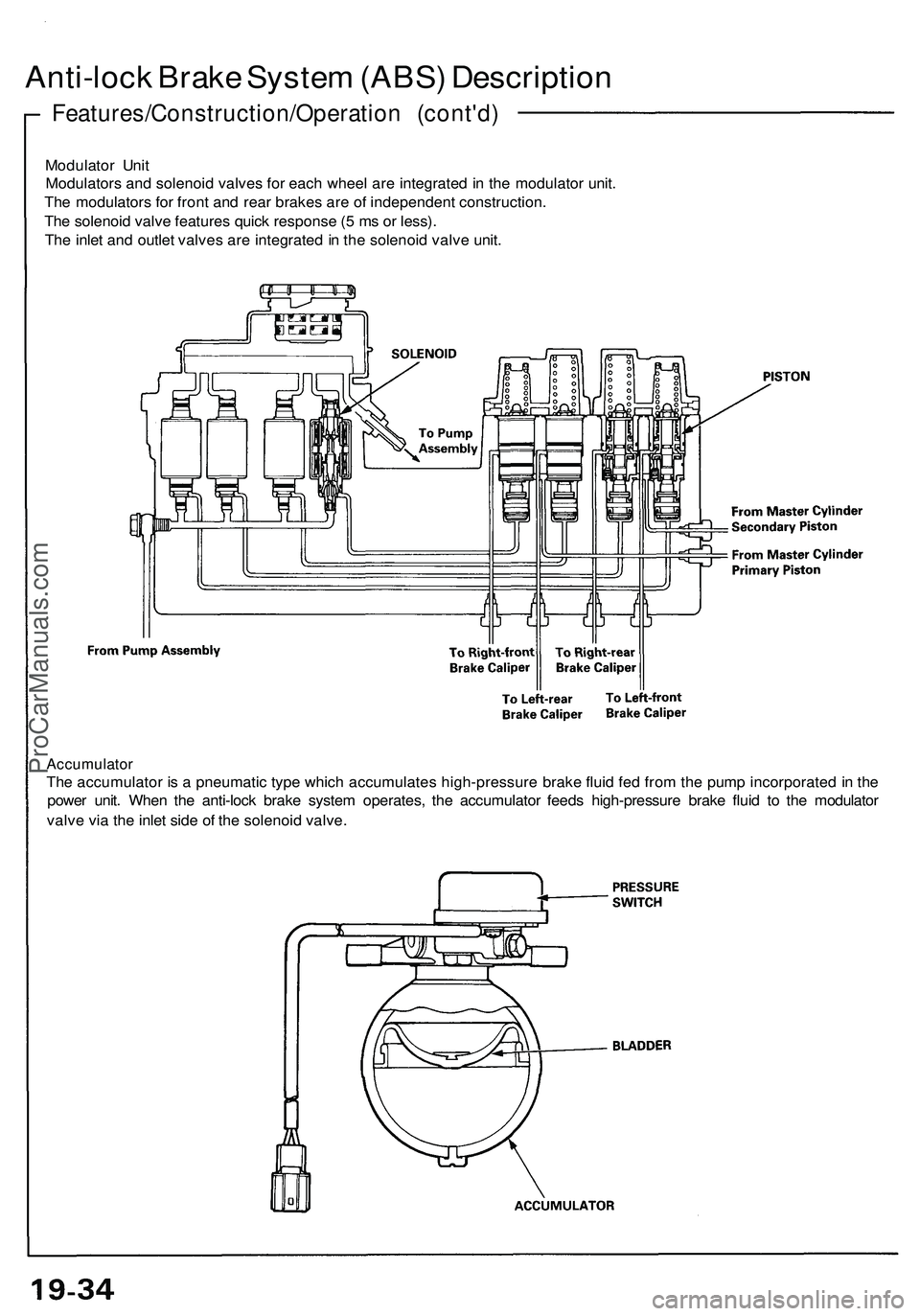
Accumulator
The accumulator is a pneumatic type which accumulates high-pressure brake fluid fed from the pump incorporated in the
power unit. When the anti-lock brake system operates, the accumulator feeds high-pressure brake fluid to the modulator
valve via the inlet side of the solenoid valve.
Modulator Unit
Modulators and solenoid valves for each wheel are integrated in the modulator unit.
The modulators for front and rear brakes are of independent construction.
The solenoid valve features quick response (5 ms or less).
The inlet and outlet valves are integrated in the solenoid valve unit.
Features/Construction/Operation (cont'd)
Anti-lock Brake System (ABS) DescriptionProCarManuals.com
Page 1016 of 1503
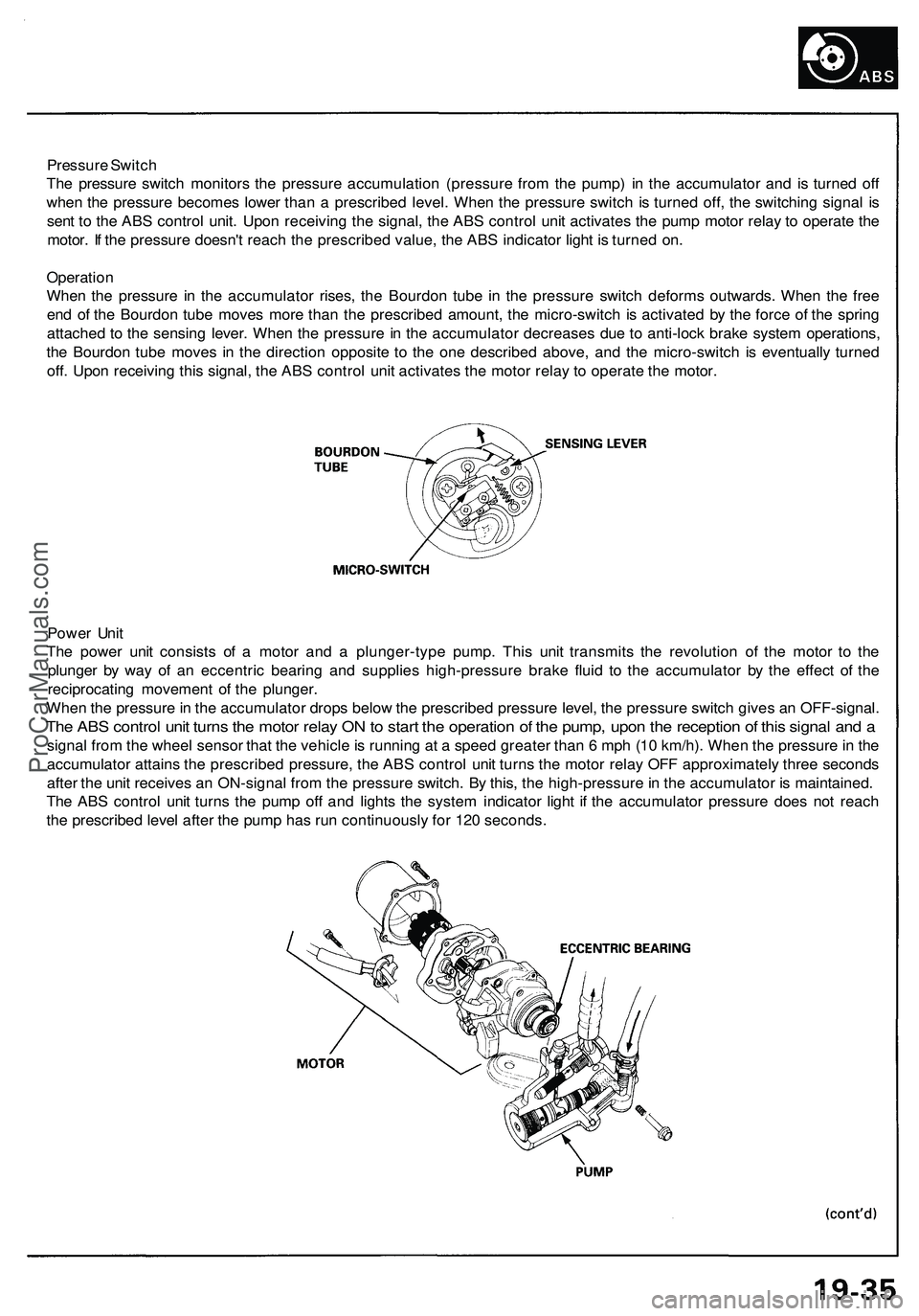
Pressure Switch
The pressure switch monitors the pressure accumulation (pressure from the pump) in the accumulator and is turned off
when the pressure becomes lower than a prescribed level. When the pressure switch is turned off, the switching signal is
sent to the ABS control unit. Upon receiving the signal, the ABS control unit activates the pump motor relay to operate the
motor. If the pressure doesn't reach the prescribed value, the ABS indicator light is turned on.
Operation
When the pressure in the accumulator rises, the Bourdon tube in the pressure switch deforms outwards. When the free
end of the Bourdon tube moves more than the prescribed amount, the micro-switch is activated by the force of the spring
attached to the sensing lever. When the pressure in the accumulator decreases due to anti-lock brake system operations,
the Bourdon tube moves in the direction opposite to the one described above, and the micro-switch is eventually turned
off. Upon receiving this signal, the ABS control unit activates the motor relay to operate the motor.
Power Unit
The power unit consists of a motor and a plunger-type pump. This unit transmits the revolution of the motor to the
plunger by way of an eccentric bearing and supplies high-pressure brake fluid to the accumulator by the effect of the
reciprocating movement of the plunger.
When the pressure in the accumulator drops below the prescribed pressure level, the pressure switch gives an OFF-signal.
The ABS control unit turns the motor relay ON to start the operation of the pump, upon the reception of this signal and a
signal from the wheel sensor that the vehicle is running at a speed greater than 6 mph (10 km/h). When the pressure in the
accumulator attains the prescribed pressure, the ABS control unit turns the motor relay OFF approximately three seconds
after the unit receives an ON-signal from the pressure switch. By this, the high-pressure in the accumulator is maintained.
The ABS control unit turns the pump off and lights the system indicator light if the accumulator pressure does not reach
the prescribed level after the pump has run continuously for 120 seconds.ProCarManuals.com
Page 1017 of 1503
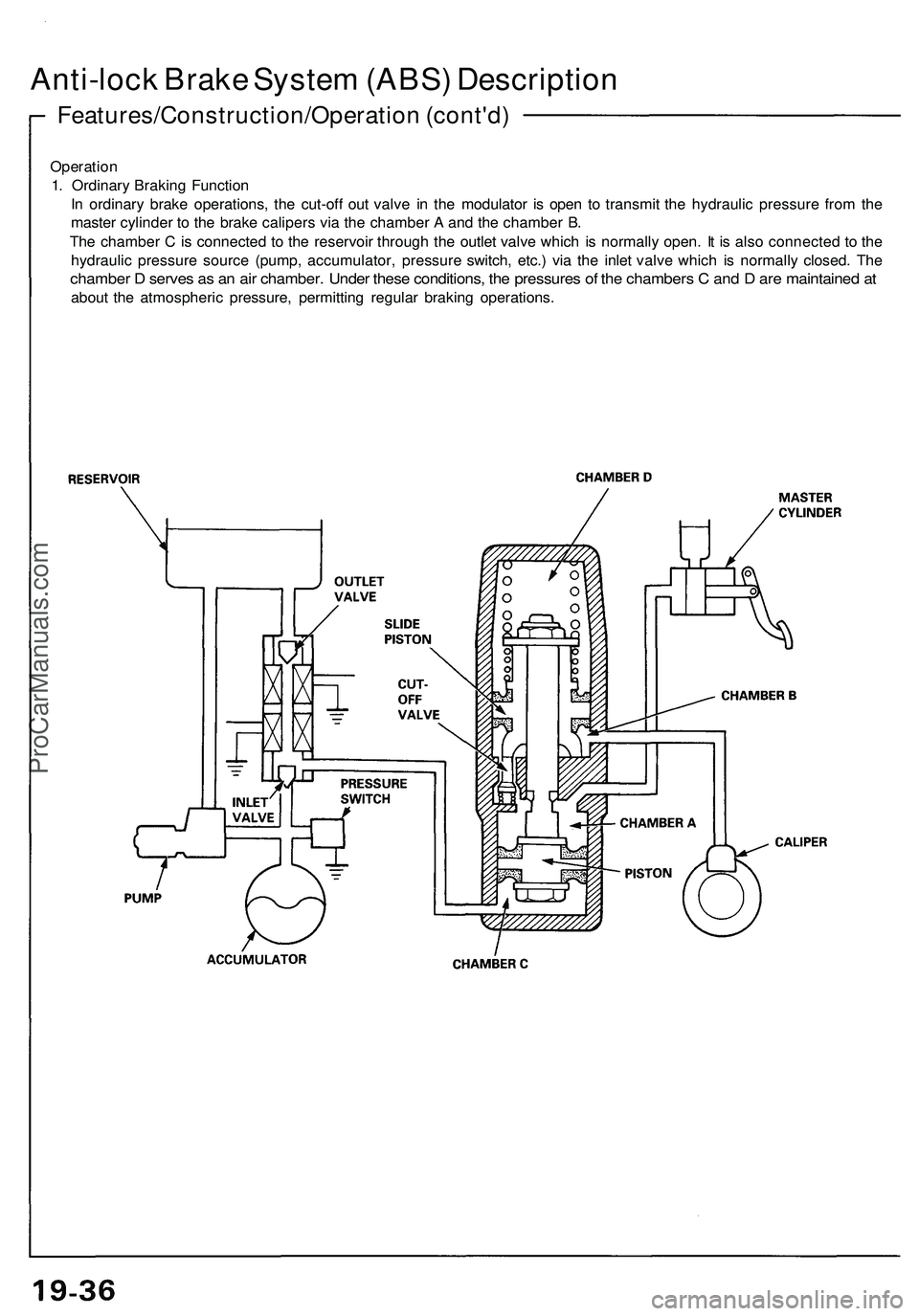
Operation
1. Ordinary Braking Function
In ordinary brake operations, the cut-off out valve in the modulator is open to transmit the hydraulic pressure from the
master cylinder to the brake calipers via the chamber A and the chamber B.
The chamber C is connected to the reservoir through the outlet valve which is normally open. It is also connected to the
hydraulic pressure source (pump, accumulator, pressure switch, etc.) via the inlet valve which is normally closed. The
chamber D serves as an air chamber. Under these conditions, the pressures of the chambers C and D are maintained at
about the atmospheric pressure, permitting regular braking operations.
Features/Construction/Operation (cont'd)
Anti-lock Brake System (ABS) DescriptionProCarManuals.com
Page 1018 of 1503
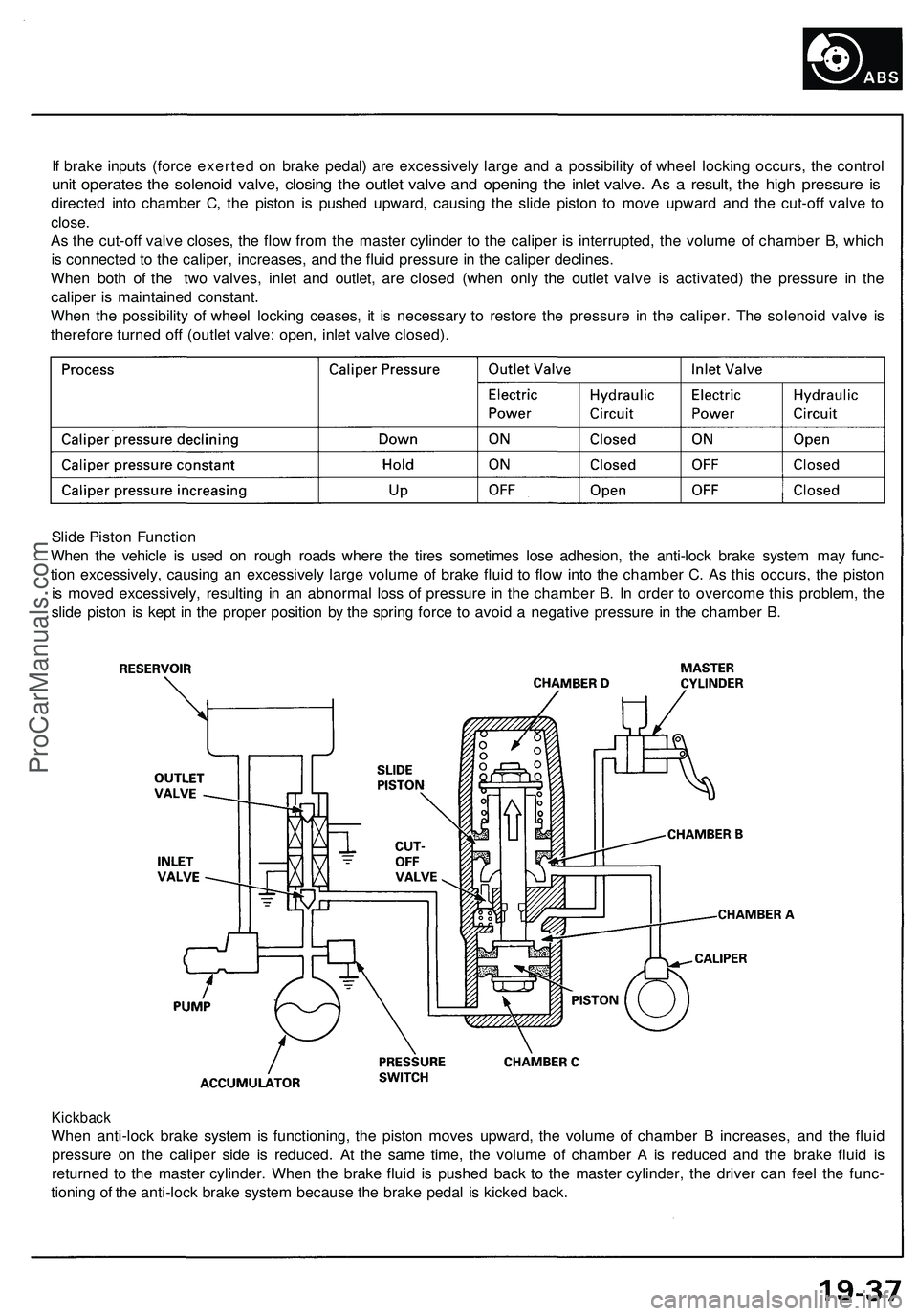
If brake inputs (force exerted on brake pedal) are excessively large and a possibility of wheel locking occurs, the control
unit operates the solenoid valve, closing the outlet valve and opening the inlet valve. As a result, the high pressure is
directed into chamber C, the piston is pushed upward, causing the slide piston to move upward and the cut-off valve to
close.
As the cut-off valve closes, the flow from the master cylinder to the caliper is interrupted, the volume of chamber B, which
is connected to the caliper, increases, and the fluid pressure in the caliper declines.
When both of the two valves, inlet and outlet, are closed (when only the outlet valve is activated) the pressure in the
caliper is maintained constant.
When the possibility of wheel locking ceases, it is necessary to restore the pressure in the caliper. The solenoid valve is
therefore turned off (outlet valve: open, inlet valve closed).
Slide Piston Function
When the vehicle is used on rough roads where the tires sometimes lose adhesion, the anti-lock brake system may func-
tion excessively, causing an excessively large volume of brake fluid to flow into the chamber C. As this occurs, the piston
is moved excessively, resulting in an abnormal loss of pressure in the chamber B. In order to overcome this problem, the
slide piston is kept in the proper position by the spring force to avoid a negative pressure in the chamber B.
Kickback
When anti-lock brake system is functioning, the piston moves upward, the volume of chamber B increases, and the fluid
pressure on the caliper side is reduced. At the same time, the volume of chamber A is reduced and the brake fluid is
returned to the master cylinder. When the brake fluid is pushed back to the master cylinder, the driver can feel the func-
tioning of the anti-lock brake system because the brake pedal is kicked back.ProCarManuals.com
Page 1019 of 1503
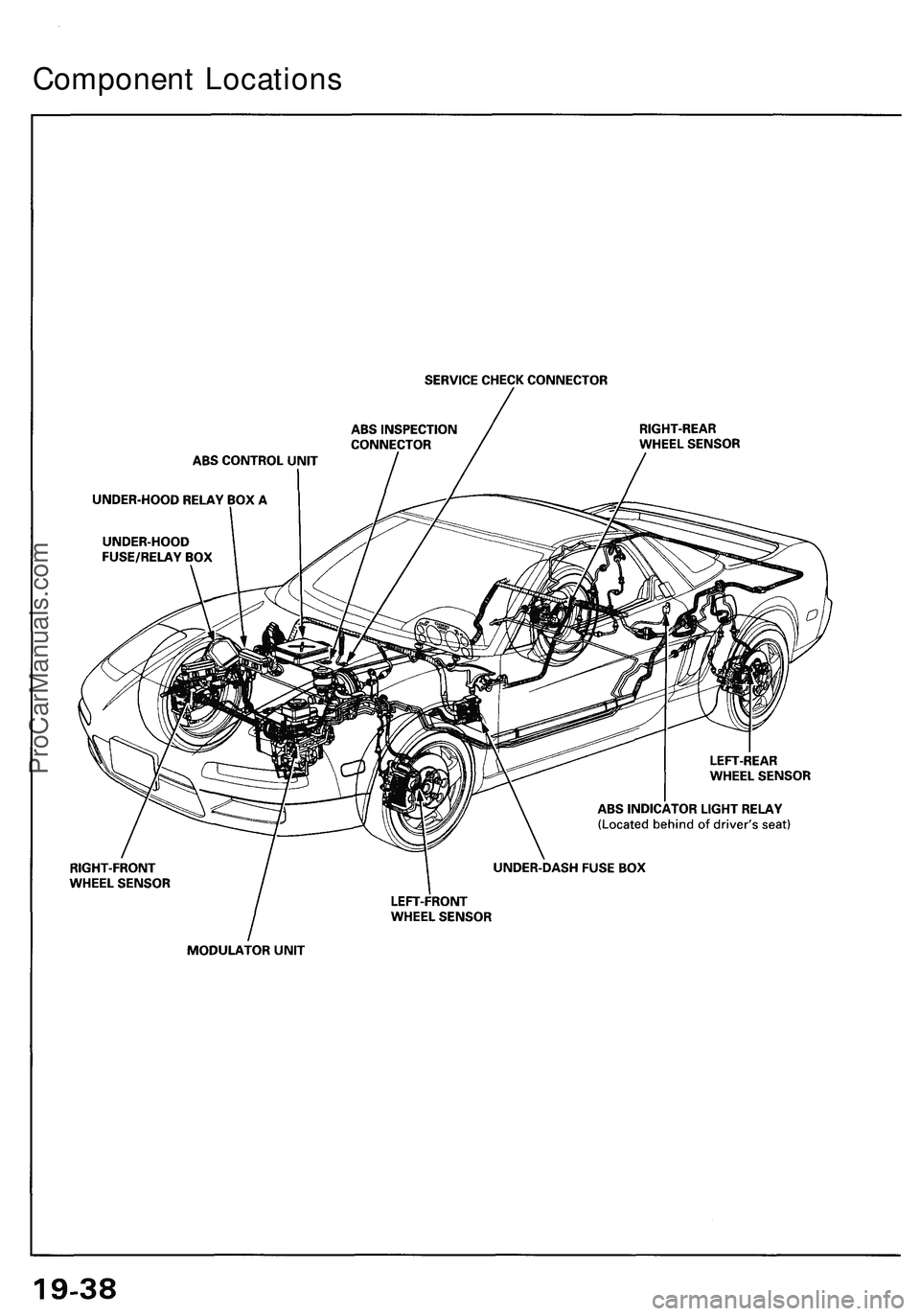
Component LocationsProCarManuals.com
Page 1020 of 1503
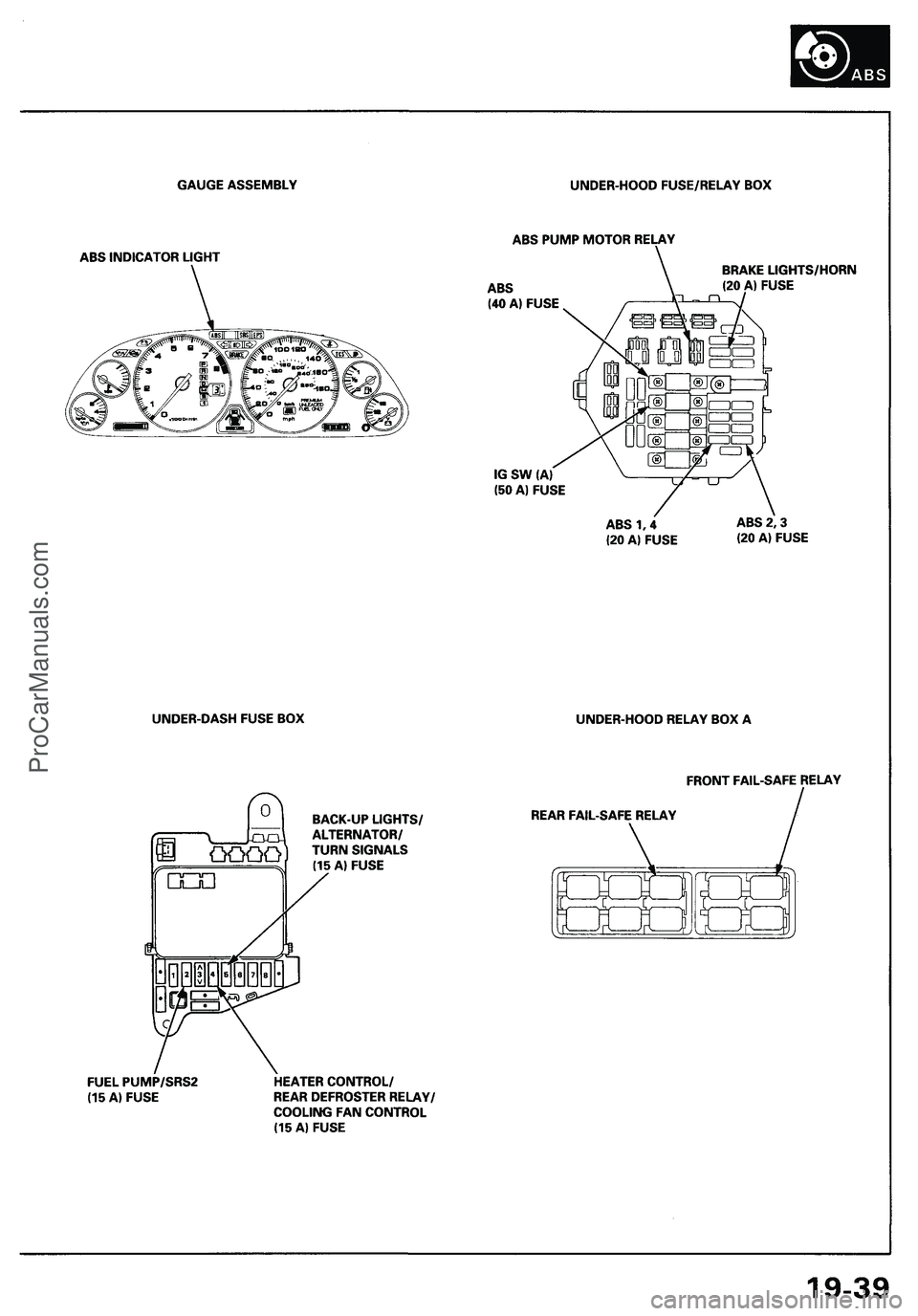
ProCarManuals.com